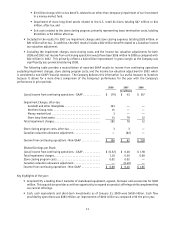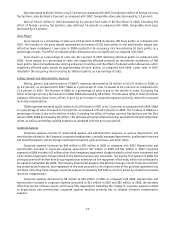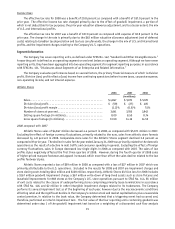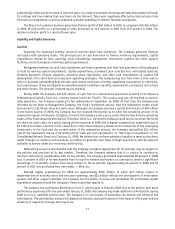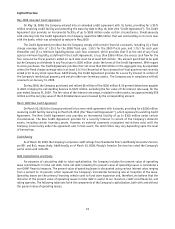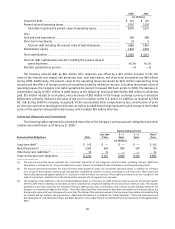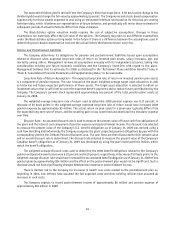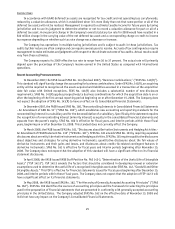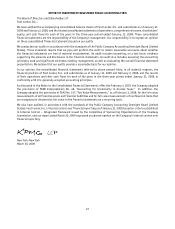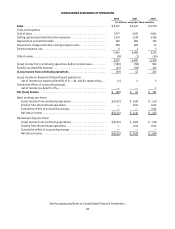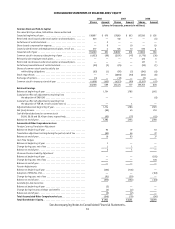Foot Locker 2008 Annual Report Download - page 37
Download and view the complete annual report
Please find page 37 of the 2008 Foot Locker annual report below. You can navigate through the pages in the report by either clicking on the pages listed below, or by using the keyword search tool below to find specific information within the annual report.
21
Other Commercial Commitments
Total
Amounts
Committed
Amount of Commitment Expiration by Period
Less than
1 Year
2 – 3
Years
3 – 5
Years
After 5
Years
(in millions)
Line of credit ..................... $ 166 $ — $166 $ — $ —
Standby letters of credit ............. 9 — 9 — —
Purchase commitments(4) ............ 1,462 1,462 — — —
Other(5) .......................... 69 26 34 9 —
Total commercial commitments ........ $1,706 $1,488 $209 $ 9 $ —
(4) Represents open purchase orders, as well other commitments for merchandise purchases, at January 31, 2009. The Company is obligated
under the terms of purchase orders; however, the Company is generally able to renegotiate the timing and quantity of these orders with
certain vendors in response to shifts in consumer preferences.
(5) Represents payments required by non-merchandise purchase agreements and minimum royalty requirements.
The Company does not have any off-balance sheet financing, other than operating leases entered into in the normal
course of business as disclosed above, or unconsolidated special purpose entities. The Company does not participate
in transactions that generate relationships with unconsolidated entities or financial partnerships, including variable
interest entities. The Company’s policy prohibits the use of derivatives for which there is no underlying exposure.
In connection with the sale of various businesses and assets, the Company may be obligated for certain
lease commitments transferred to third parties and pursuant to certain normal representations, warranties, or
indemnifications entered into with the purchasers of such businesses or assets. Although the maximum potential
amounts for such obligations cannot be readily determined, management believes that the resolution of such
contingencies will not significantly affect the Company’s consolidated financial position, liquidity, or results of
operations. The Company is also operating certain stores for which lease agreements are in the process of being
negotiated with landlords. Although there is no contractual commitment to make these payments, it is likely that
leases will be executed.
Critical Accounting Policies
Management’s responsibility for integrity and objectivity in the preparation and presentation of the Company’s
financial statements requires diligent application of appropriate accounting policies. Generally, the Company’s
accounting policies and methods are those specifically required by U.S. generally accepted accounting principles.
Included in the “Summary of Significant Accounting Policies” note in “Item 8. Consolidated Financial Statements and
Supplementary Data” is a summary of the Company’s most significant accounting policies. In some cases, management
is required to calculate amounts based on estimates for matters that are inherently uncertain. The Company believes
the following to be the most critical of those accounting policies that necessitate subjective judgments.
Business Combinations
The Company accounts for acquisitions of other businesses in accordance with SFAS No. 141, “Business
Combinations” (“SFAS No. 141”). SFAS No. 141 requires that the Company record the net assets of acquired businesses at
fair value, and make estimates and assumptions to determine the fair value of these acquired assets and liabilities. The
Company allocates the purchase price of acquired businesses based, in part, upon internal estimates of cash flows and
considering the report of a third-party valuation expert retained to assist the Company. Changes to the assumptions
used to estimate the fair value could affect the recorded amounts of the assets acquired and the resultant goodwill.
Merchandise Inventories
Merchandise inventories for the Company’s Athletic Stores are valued at the lower of cost or market using the
retail inventory method (“RIM”). The RIM is commonly used by retail companies to value inventories at cost and
calculate gross margins due to its practicality. Under the retail method, cost is determined by applying a cost-to-retail
percentage across groupings of similar items, known as departments. The cost-to-retail percentage is applied to ending
inventory at its current owned retail valuation to determine the cost of ending inventory on a department basis. The
RIM is a system of averages that requires management’s estimates and assumptions regarding markups, markdowns and
shrink, among others, and as such, could result in distortions of inventory amounts.


